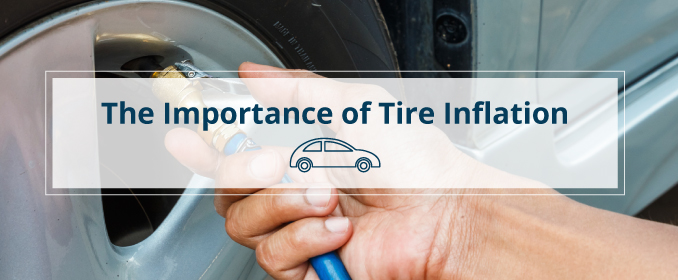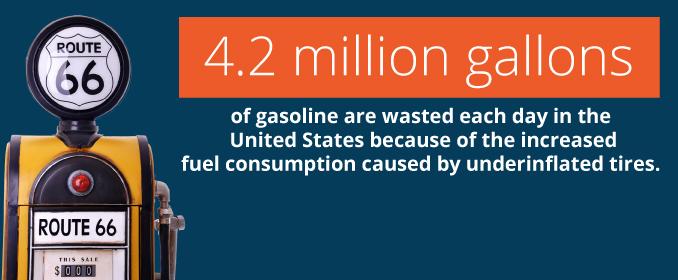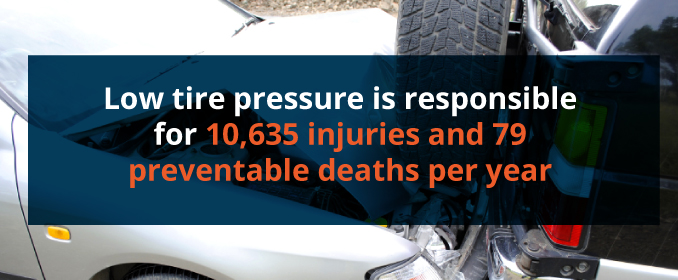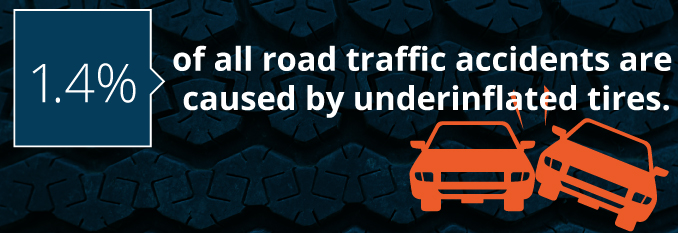
Vehicles are expensive and considering which one to buy can take a lot of time, so thinking about the tires on your car may also seem too time-consuming to consider. The variety of tires available seems to increase every year, and not everyone has the time or the patience to become an expert in them.
Whatever type of tire your car requires, they can be ruined through improper use. Proper tire pressure is essential: Not only is proper maintenance of your tires a factor in extending their serviceable life, but incorrect tire pressure can cause accidents, leading to injury and preventable deaths. Take a little time to read our guide on tire pressure to save yourself money, keep within the law and prevent accidents.
Why Are Tires So Expensive?
You may have noticed that tire prices vary widely on versions made for the same vehicle. Some of that price difference is simply because some tire manufacturers believe their brand gives them the opportunity to charge a little more. New tire manufacturers may use price discounting to break into the market. However, technical factors also influence the amount a tire costs to produce.
Rubber wears down quickly and to prolong the wear, manufacturers have invested in material blends and processing treatments that will harden the rubber and stop it from wearing off — those tires are more expensive upfront, but cheaper in the long run because they will last longer.
The height of the sides, or “walls,” of the tire will also influence its price. This is because tires with deeper walls contain more material. Similarly, some tires have deeper treads, which means there is just more rubber around the outer edge of the tire. The additional material means your tires will take longer to wear down, also extending their lifespan.
Contact Us Learn More Find a Dealer Near You
How Can I Save Money On Tires?
Owner behavior greatly influences the durability of tires. Incorrect tire pressure is estimated to be the top cause of accelerated tire wear. Even if you buy expensive tires, you will only get the service life of cheap tires if they are incorrectly inflated. Similarly, you can reap better mileage out of a cheap tire if you select the appropriate tire pressure.
Tire tread has a pattern of grooves, which isn’t just there for aesthetics. The pattern also helps the tire grip the road and redirects water from wet road surfaces out towards the sides of the tires. This pattern must be maintained in order to be effective.
If one area of the tire wears down faster than the others, it’s compromised, as grip and water ducting performance is rendered useless. Uneven wear can make a tire “bald” even if most of the tire surface appears to be in good condition. Incorrect tire pressure is the biggest cause of uneven tire wear.
Overinflation
Overinflated tires bulge. This creates a narrow central band of the tire’s surface that has contact with the road while the outer areas are kept off the ground. This pattern puts more weight on a reduced surface of the tire causing a central band of the tire’s tread to wear out faster. This is called “center wear” and is a sure sign of tire overinflation.
You may be tempted to overinflate your tires to suit your local road conditions. Overinflated tires give a harder ride and can make a car with soggy suspension easier to handle. However, highly inflated tires are also more susceptible to punctures from sharp objects in the road, increasing the risk of blowout.
Underinflation
What happens if you drive with low tire pressure? You might think that the risks involved with overinflation means you would be better off erring towards underinflation. Unfortunately, underinflation can cause irregular wear, too. This will lead to bald tires faster than they should be.
Underinflated tires put a lot more surface in contact with the road. However, this causes the outside sections of the tire to wear out faster than they should. These regions of the tire surface are known as “shoulders.” Thus, the pattern of wear caused by underinflation is called “shoulder wear.”
More importantly, underinflated tires also cause the avoidable expense of poor fuel consumption. According to the Society of Automotive Engineers, about 4.2 million gallons of gasoline are wasted each day in the United States because of the increased fuel consumption caused by underinflated tires.
Why Is Tire Pressure Important?
Car manufacturers recommend specific types of tires for their vehicles, and tire manufacturers develop their products for particular use. If you don’t keep your tires at the recommended pressure, you are not getting the performance out of your tires or your car that the manufacturers promised you.
Correct pressure goes a long way in delivering your tires’ recommended life. You will also get a more comfortable ride and improve fuel efficiency. However, the most important factor to consider is safety.
Disasters Due to Tire Pressure
The importance of checking tire pressure is heightened by safety issues. The National Highway Traffic Safety Administration (NHTSA) calculates that low tire pressure is responsible for 10,635 injuries and 79 preventable deaths per year in the United States.
Since 2008, federal law requires that all cars sold in the U.S. should have a tire pressure monitor warning on the dash. The NHTSA estimates that these systems will prevent a total of 260 thousand accidents per year. Those accidents are generally assumed to be caused by low tire pressure, based on a study made by Indiana University that reported 1.4 percent of all road traffic accidents are caused by underinflated tires.
How Much Air Should Be in My Tires?
There is no single answer to how much air pressure your tires need. This is because each tire make and type has different air pressure requirements. However, you have the correct information on hand already: You just need to know where to look for it.
You might be surprised to know that the correct pressure for your tires does not come from your tire manufacturer. You need to look for the pressure recommendations for your car, not for your tires.
- The best place to look for the correct pressure for your tires is in your car’s owner’s manual. If you can’t find that, don’t worry. The car manufacturer has placed hidden messages on your car giving you advice on how to inflate your tires. Take a hunt around.
- Look on the edge of the driver’s door. This is the part of the door that looks straight ahead and the door frame when the door is shut. You should see a large sticker or placard with a variety of information printed on it. The correct tire pressure for your car should be listed there.
- Look at the door frame if you don’t find the tire pressure on the door, as some manufacturers put the placard there instead.
- Open your glove box and look inside the door for a printed sticker. You will find the tire pressure among the facts on that placard.
- Open the door to your fuel cap. There may be a sticker with a lot of information on the back of that door. Your correct tire pressure will be listed there.
What Should My Tire Pressure Be?
There is one piece of information that won’t help you know your correct tire pressure, and that is the code that is printed on the side of your tires. It may seem strange to hear that you shouldn’t use the tire manufacturer’s information when looking for the correct pressure for those tires. In fact, if you find the tire pressure rating on the tire, you could create great danger by following it. Why? The tire pressure written on the tire is not the recommended value for regular use of the car. It is the maximum air pressure the tire was manufactured to contain, and so it is an indication of the tire’s ultimate strength rather than its operating conditions.
Just for information, you can find the tire pressure rating on the side of the tire. The information printed on tires is difficult to read because it is created with raised rubber that is the same color as the tire. Park the car in sunlight, or take a flashlight to read the tire. Try to create a shadow from the letters in order to see them better.
The tire pressure is usually written immediately around the rim. It will read something similar to “Max. Pressure 240 kPa (35 psi).” The “kPa” stands for kilopascals, which is a unit of pressure. In the United States, you are more likely to see psi on pressure gauges. This stands for “pounds per square inch.”
Once again, don’t use the pressure printed on the side of your tire as a guide for how much air to put into them. Rely on the recommendations printed on the car instead.
How Do I Check Tire Pressure?
The maximum pressure for modern tires is between 44 and 51 PSI. You can buy a tire pressure gauge at an auto supply store and some gas stations — you should find it in the small spare parts section at the gas station. You don’t need to buy your own gauge, though. Most gas stations have an air compressor for customers to fill their tires. In most cases this service is free.
In order to connect your gauge or the compressor to your tires, you need to look for the air inlet valve on your tire. This is a small round cap, which should have a stalk behind it. Unscrew the cap. Don’t worry that taking off the cap will let all the air out of your tires, as the air nozzle on your tire has a valve in it that keeps air from escaping. You’ll have to push in the trap at the opening of the nozzle in order to unblock the air flow.
If you want to let your tire down, you’ll have to force a nail or large pin into the nozzle to push the valve trap in. You’ll have to maintain force on the nail to prevent the trap from pushing it out and resealing the opening. The air pressure gauge and the air compressor have a small pin in the center of their connectors. This pushes in the valve trap to connect the device to the tire.
As soon as the valve trap is released, the compressor or gauge valve becomes part of the tire’s atmosphere. The dial on the gauge or compressor will then show how much pressure is in your tire.
One thing to note is that the air in a tire expands with heat and contracts when it cools. This means that the pressure in your tire varies, with weather conditioner after long drives. The recommended reading that car manufacturers give is based on the pressure in a cold tire.
So, if you go to a gas station to check your pressure, don’t drive very much before you go. Go straight to the nearest service station to ensure that your tires will still be relatively cold. Another interesting fact about tire temperature: Underinflated tires heat up faster.
Tire Pressure Maintenance
You may be wondering how often you should check your tire pressure. Tire pressure does not stay the same. But — setting aside complicating factors such as altitude and temperature — if you measure the pressure in your tires cold every day you will eventually notice that the pressure is successively lower by just a small amount every day. Over time, this deflation will amount to a serious underpressurization.
Tires usually lose one or two pounds of air per month in cold weather. In warm weather that drop accelerates. So, make a habit of checking the pressure in your tires as part of routine tasks, for example, if you wash your car every Sunday, make a point of checking the air pressure in your tires at the same time. If you fill up your tank once a week, drive over to the air compressor while you are in the gas station and check your tires.
Checking Pressure at Home
Quincy Compressor makes air compressors for home use. These are aimed at home improvement projects, but they can also fill up your tires. If you have industrial vehicles, you’re advised to have your own compressor for tire pressure maintenance housed in your depot’s shop. You can contact Quincy Compressor to find out more about how we can help you with compressed air issues, such as tire pressure.
You may not be located close to the Quincy Compressor headquarters. However, don’t worry. We have a network of service centers and sales representative throughout the United States. Take a look at our Service Center Locator to find the nearest one to you.
Quincy Compressor implements legendary performance and reliability. We have been trusted in the market for nearly a century. Find out how Quincy Compressor can help you maintain the proper pressure in your tires.





